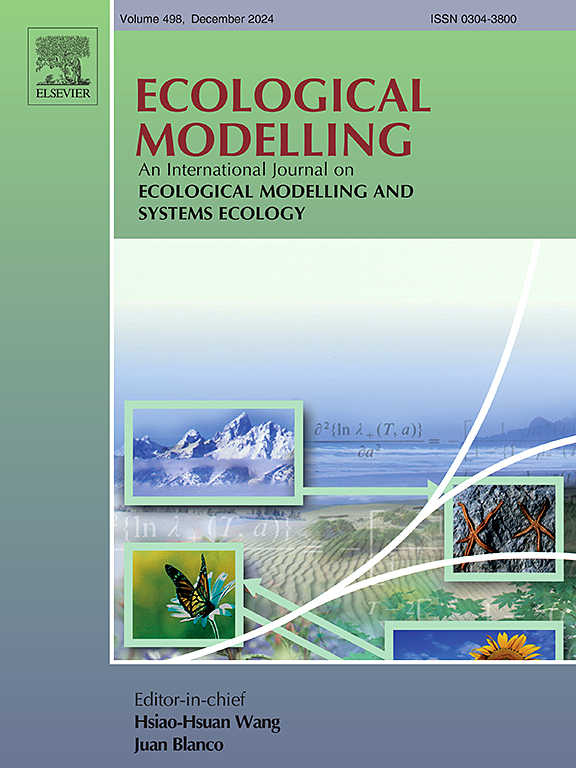敏感湿地水鸟栖息地可用性下降:气候变化对埃布罗河三角洲的影响
IF 2.6
3区 环境科学与生态学
Q2 ECOLOGY
引用次数: 0
摘要
沿海湿地等生物多样性丰富、生产力高且脆弱的地区正日益受到人为干扰的威胁,导致栖息地丧失。栖息地的丧失是生物多样性衰退的重要驱动因素,严重影响了物种的分布和行为,增加了物种灭绝的风险。为了解决这些问题,我们利用埃布罗河三角洲长达十年的水鸟功能群出现数据集开发了一个物种分布模型(SDM),其中特别关注了代表该湿地最主要物种的杓鹬科。该模型旨在预测各种气候变化情景下潜在的栖息地损失,特别是政府间气候变化专门委员会(IPCC)代表性浓度途径(RCP)4.5 和 8.5 中概述的情景,并跨越三个不同的时间段。我们的 SDM 表明,水鸟的栖息地适宜性受到温度变化、累积降水量增加和地形海拔降低的显著影响。预测表明,考虑到特定的气候情景,这些水鸟物种的可用栖息地在研究期间有所增加。然而,将海平面上升和洪涝地区纳入模型后,水鸟的可用栖息地面积在长期内将急剧下降,降幅高达 50%(RCP 4.5)和 70%(RCP 8.5)。由于埃布罗河三角洲是成千上万只水鸟整个生命周期的重要沿海湿地,因此这一需求尤为迫切。必须立即采取有针对性的保护行动,以保护这些物种的重要栖息地。本文章由计算机程序翻译,如有差异,请以英文原文为准。

Habitat availability decline for waterbirds in a sensitive wetland: Climate change impact on the Ebro Delta
The highly biodiverse, productive and vulnerable areas, such as coastal wetlands, are increasingly threatened by human-induced disturbances, resulting in habitat loss. This habitat loss is a critical driver of biodiversity decline and significantly impacts species distribution and behavior, increasing the risk of extinctions. To address these concerns, we developed a Species Distribution Model (SDM) using a decade-long dataset of waterbird functional group occurrences in the Ebro Delta, with a particular focus on the Ardeidae family, which represents the most prominent species in the wetland. This model aims to predict potential habitat loss under various climate change scenarios, specifically those outlined in the Intergovernmental Panel on Climate Change (IPCC) Representative Concentration Pathways (RCP) 4.5 and 8.5, across three distinct time periods.
Our SDM revealed that habitat suitability for waterbirds was notably influenced by temperature variations, increased cumulative precipitation, and lower terrain elevation. Predictions indicate an increase in available habitat for these waterbird species over the study periods considering the specified climate scenarios. However, the incorporation of sea-level rise and flooded areas into the models unveiled a dramatic decline in available areas for waterbirds in the long-term, reaching up to 50 % (RCP 4.5) and 70 % (RCP 8.5) reduction.
Our study highlights the urgent need for conservation efforts to mitigate the substantial reduction in available habitat for waterbirds. This need is especially crucial due to the Ebro Delta's importance as a vital coastal wetland for many thousands of waterbirds throughout their entire life cycle. Immediate and targeted conservation actions are imperative to safeguard the essential habitats for these species.
求助全文
通过发布文献求助,成功后即可免费获取论文全文。
去求助
来源期刊

Ecological Modelling
环境科学-生态学
CiteScore
5.60
自引率
6.50%
发文量
259
审稿时长
69 days
期刊介绍:
The journal is concerned with the use of mathematical models and systems analysis for the description of ecological processes and for the sustainable management of resources. Human activity and well-being are dependent on and integrated with the functioning of ecosystems and the services they provide. We aim to understand these basic ecosystem functions using mathematical and conceptual modelling, systems analysis, thermodynamics, computer simulations, and ecological theory. This leads to a preference for process-based models embedded in theory with explicit causative agents as opposed to strictly statistical or correlative descriptions. These modelling methods can be applied to a wide spectrum of issues ranging from basic ecology to human ecology to socio-ecological systems. The journal welcomes research articles, short communications, review articles, letters to the editor, book reviews, and other communications. The journal also supports the activities of the [International Society of Ecological Modelling (ISEM)](http://www.isemna.org/).
 求助内容:
求助内容: 应助结果提醒方式:
应助结果提醒方式:


